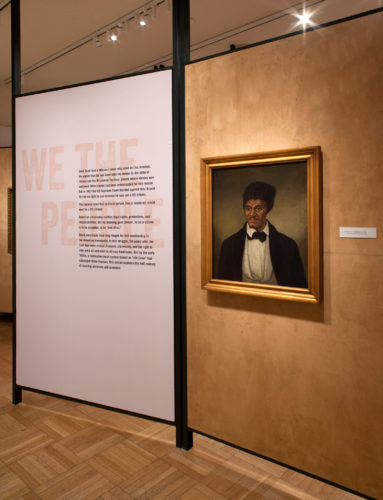How Black Citizenship Was Won, and Lost
Share
Explore Our Galleries
Breaking News!
Today's news and culture by Black and other reporters in the Black and mainstream media.
Ways to Support ABHM?
By Jennifer Schuessler, New York Times

The exhibition opens with a portrait of Dred Scott, whose legal case prompted the infamous 1857 Supreme Court ruling saying that African-Americans, free or enslaved, could never be citizens. Credit – Glenn Castellano/New-York Historical Society
“Black Citizenship in the Age of Jim Crow,” an exhibition at the New-York Historical Society, traces the gains, and reversals, of the post-Civil War struggle over racial equality.
The post-Civil War Reconstruction era — which saw the dramatic expansion of rights for African-Americans, followed by their violent rollback — is one of the most poorly understood periods in American history. “Black Citizenship in the Age of Jim Crow,” an exhibition about Reconstruction and its aftermath at the New-York Historical Society through March 3, doesn’t draw explicit parallels to today’s politics. But perhaps it doesn’t have to.
“The struggle over who has the right to citizenship and who belongs has been at the heart of American life over centuries,” Marci Reaven, vice president of history exhibitions at the museum, said on a recent afternoon. “This was a period that had incredible strides forward in equality for everyone,” Ms. Reaven, who curated the exhibition with Lily Wong, assistant curator, continued. “But it was also a story of incredible strides backwards.”
The exhibition, which fills three small upstairs galleries here, covers the legal and political landmarks, but it also includes poignant artifacts that show how ordinary people fought the battle for — and against — racial equality on the ground, in what Ms. Reaven called “a constant push and pull.” The show chronicles the many ways African-American organizers, activists and artists resisted Jim Crow, even after electoral politics were closed to them. And a section on the post-Civil War growth of the prison system prompts associations with today’s analogy of mass incarceration as “the new Jim Crow,” raising questions about the way its legacy lingers, even 50 years after the civil rights movement dismantled Jim Crow as a formal legal system…
Read the full article here
Read more Breaking News here
View more galleries from the ABHM here









Comments Are Welcome
Note: We moderate submissions in order to create a space for meaningful dialogue, a space where museum visitors – adults and youth –– can exchange informed, thoughtful, and relevant comments that add value to our exhibits.
Racial slurs, personal attacks, obscenity, profanity, and SHOUTING do not meet the above standard. Such comments are posted in the exhibit Hateful Speech. Commercial promotions, impersonations, and incoherent comments likewise fail to meet our goals, so will not be posted. Submissions longer than 120 words will be shortened.
See our full Comments Policy here.